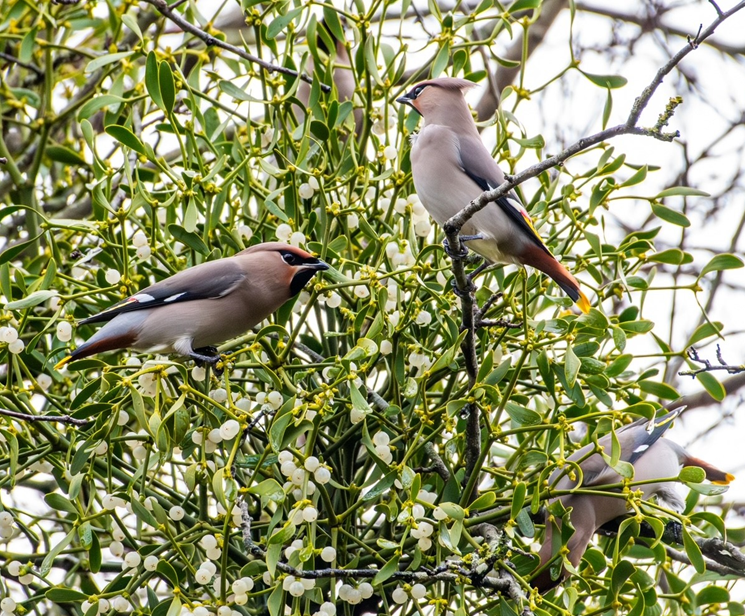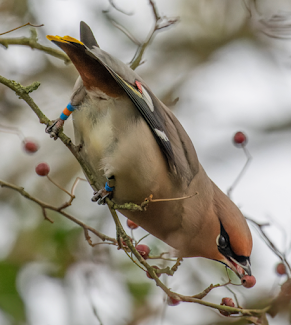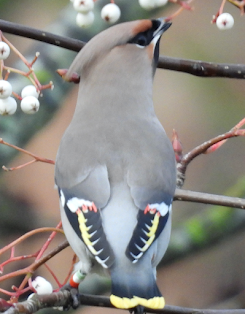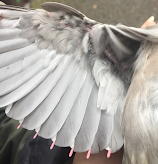A MERRY WAXWING XMAS AND A HAPPY WAXWING
NEW YEAR!
A Happy New Year
and massive thank you to all birders, observers and photographers for reporting
their colour-ringed Waxwing sightings to us. It has certainly been a busy
December and start to January. See map by Euan Ferguson (below). See Sam Lopez
on Twitter @Naturalist_Sam for an animated version!

It is clear from
the map that many of the Waxwings moved on south out of Scotland and kept on
going with several sightings south of London before the New Year. And
“returning birds?!” (not on map) to Denmark, Norway and Sweden already!
RYR Farnham, Surrey 7/1/24, Emma Stephenson
BWR Greater Malvern, Worcestershire 6/1/24, Andy
Richardson

WGW Uckfield, Sussex 6/1/24, Keith DP Wilson

YNW Barnoldswick, East Lancashire 30/11/23, Dave Markendale
However
just as interesting as the movers are the stayers. Birds in the north of
England included YNW, found in Barnoldswick, East Lancashire on 30th
Nov. which then turned up over a month later on 4th. Jan only 55km
to the east in Middleton Quernhow, North Yorkshire. RYW
was in Gainsborough, Lincolnshire 17th Dec. then turned up a week
later on Xmas eve in Newton Aycliffe, Co Durham 145km to the north west.

RYW Gainsborough,Lincolnshire 17/12/23, Joe Downing
And a few were still
hanging on in Scotland.Lorraine McCormack
photographed juvenile female WOW (below) at the south approaches to the Kincardine
Bridge near Falkirk on New Years Day and also managed to capture a bit of pair
bonding between WOW and an unringed male, passing a berry back and forth to
each other repeatedly.


Hassop Station (Café depending on the reporters
tendancies!), near Bakewell in Derbyshire was the place to be though if you’re
a Waxwing with 250+ reported feeding on hawthorn berries along the old railway
line. 10 colour-ringed birds have been reported from here so far between 19th
Dec. and 13th Jan. See some photos below:

LYW after drinking, Hassop 6/1/24, Tim Russon

OGW “Where’s all the berries gone?” Hassop 6/1/24, Peter Garrity

WYW Hassop 13/1/24, Richard Oswold
Waxwings generally
show little flock fidelity and pretty random dispersal when they arrive in the
UK so it is interesting to speculate how flock faithful some of these birds at
Hassop Station are. Seven have come from the same flock, same day ringing in
Elgin on 13th Nov., 1 from Aberdeen on 4th Nov. and 1
from Orkney on 7th Nov. We’ll take a closer look at this in a future
post.
The large flock at
Hassop is feeding on hawthorn berries, a berry species they all but ignored in NE
Scotland this winter, much preferring the rowan berries. It has been very
interesting to see from photographs and information provided by observers what
the Waxwings are feeding on at various other locations around the country.
LLO photographed by
Keith Gillon near Longniddry, East Lothian 7/1/24 was not only notable for
still being in Scotland but also for feeding on rose hips.
Keith
commented, “The birds were managing to feed on the rose hips though they maybe
did select the smaller ones.”
Interestingly
WYG, seen by Angus Croudace on 27/12, also still in Scotland in Abernethy,
Perthshire, was also feeding on rose hips. Rose hips are not just a Scottish
thing though, Andrew Merrick reported birds at Arborfield Garrison, Berkshire
feeding on them.
It was great to see the Waxwings tucking
into big juicy bunches of white rowan berries at Farnham in Surrey and
Orpington in Kent. This ornamental rowan, sorbus hupehensis, can be found
scattered around Aberdeen but none of the trees here had anywhere near such an
abundant crop of berries as those shown in the Waxwing photos from these sites.
BYR Farnham, Surrey 30/12/23, George Newton
RRB Orpington, Kent 9/1/24, R. Sim
WGW on Hawthorns Uckfield, Sussex 5/1/24, Alex Brookes
What I’ve never seen and was reported from Great Malvern in Worcestershire and Farnham in Surrey amongst other places is Waxwings feeding on Mistletoe berries.
Mistletoe is not a common berry at all up here in NE Scotland so thanks to Emma & Graham Stephenson for some extra photographs of the birds eating Mistletoe berries in Farnham and to Simon Pugh for the video footage from Great Malvern. From what I can see the Waxwings have to work quite hard to get the berries, searching around in the foliage for each single or double berries. A big bunch of red, yellow or white berries on bare stems looks a lot easier to me but having said that the Mistletoe berries do look quite large, soft and juicy.
Waxwings feeding on Mistletoe berries Farnham, Surrey 7/1/24, Emma Stephenson
BWR swallowing a Mistletoe berry Greater Malvern, Worcestershire 6/1/24, Paul Harwood Browne
As well as reporting your colour-ring sightings (and flock size and berry types) we would be interested to hear about any casualties anybody might have come across to add to our casualties table below.
Many thanks again for everybody’s tremendous contributions to our Waxwing tracking project so far.
Raymond and Grampian Ringing Group
CASUALTIES |
Cause | Number |
Car | 2 |
Cat | 2 |
Sparrowhawk | 7 |
Window strike | 20 |
| |
Total | 31 |

























































